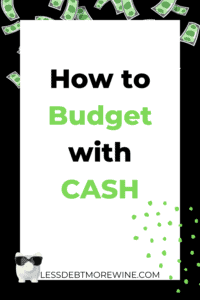Card Closing Date Vs Due Date – What’s the Difference?
THIS POST MAY CONTAIN AFFILIATE LINKS. MEANING I RECEIVE COMMISSIONS FOR PURCHASES MADE THROUGH THOSE LINKS, AT NO COST TO YOU. PLEASE READ MY DISCLOSURE FOR MORE INFO.
If you have a credit card then you likely receive a monthly statement telling you the minimum payment you’re required to make by a certain date.
But there is a lot more going on with your statement than just the payment due.
In this post, we’ll be covering:
- the difference between your credit card closing date and due date,
- how your minimum payment is calculated,
- how interest works
- and the other important information your statement covers.
What is a Credit Card Closing Date
The account statement closing date is the date on which the credit card billing cycle is closed and you enter a credit card grace period where you can pay off the credit card balance before the due date to avoid paying any interest.
What is a Due Date?
A due date for credit cards is the deadline in which you must pay the required minimum payment or even better, the entire outstanding balance on the credit card. Once it is past the due date, any balance on the card will start accruing interest.
If you fail to make a minimum payment you’ll face penalties besides the interest charged.
Where to look for Your Closing Date and Due Date on Your Statement
Credit card companies often include the due date and the closing date on their statement.
The due date is when you are expected to pay your credit card and can usually be found near the minimum amount due. If you don’t pay the full statement balance by this date, you will be charged interest.
The closing date marks the end of your billing cycle for that month and is usually included at the top and maybe referred to as the statement end dates.
The due date is usually 10-20 days after the new billing cycle begins.
Why Are The Closing Date And Due Date On A Credit Card Different?
When it comes down to it, your credit card is a short-term unsecured loan. When you use your credit card, you are essentially borrowing money from them at a predetermined interest rate. The only difference is that instead of giving them cash, you are giving them a promise. You promise to pay back what you owe with agreed-upon time frame if they let you borrow money now.
If your credit card has a balance on it, it means you owe money and will have to pay more in interest on top of the original agreed-upon monthly payment amount. The reason the due date is later than the credit card statement closing date is to allow time, known as a grace period, for you to pay the balance in full before interest charges start to accumulate.
What Happens if You Don’t Make a Payment By the Due Date
There are lots of things that could happen if you don’t make a credit card payment on time or submit late payments.
Your credit card’s terms may allow them to increase your APR, meaning you’ll be paying an even higher interest rate going forward. Additionally, you could be charged late fees. You’ll also likely see a mark on your credit report which can negatively impact your credit score.
However, if you have been a good credit card account holder, you may be able to plead for a waiver of the late payment. Though don’t expect to be granted a waiver more than once, if at all.
If it becomes a habit you’ll be considered a bad account holder. The credit card issuers may even close your account. This may result in a damaged credit score which has implications on all other aspects of your finances such as getting insurance or taking out loans.
If you fall into this category of people who often forget their payment due date, then it might be time to start using an automated service such as Mint.com or You Need A Budget. Both these services will send reminders and keep track of all your transactions on behalf of you so that all you have to do is log in at the end of each month and see what needs to be paid off.
How Interest Works on a Credit Card
Your interest rate is calculated by taking your average daily balance and adding a fixed amount to it. This is called the “annual percentage rate.”
The more you pay off, the less interest you’ll pay. For example, if you paid off the entire balance of your credit card every month, you would not incur any interest charges.
There are some credit cards that offer lower rates if you pay a certain amount in advance of the due date. These are called “deferred interest” cards and they have an APR of 0%.
You’ll oftentimes see this kind of offer with balance transfer cards. They’ll offer you 0% APR for 12 months on balance transfers up to a certain amount. But if you don’t pay off that balance by the end of the 12 months, then all of the purchases made on that card will be assessed for the interest.
And while balance transfer cards can be great to help you pay off a credit card, you do need to make sure you can pay it off in the allotted time. You’ll also need to make sure you read the fine print to see if there are any fees associated with doing a balance transfer.
How Your Minimum Payment is Calculated on Your Credit Card
Credit card companies calculate a minimum payment based on the balance of your account and the interest rate, known as the APR (Annual Percentage Rate) which will be listed on your monthly card statement.
The annual percentage rate (“APR”) is a calculation of how much interest a lender or credit card company charges for the borrowing of money. APR is calculated by dividing the amount of interest paid over one year by the amount borrowed.
The APR on your credit card can change depending on what kind of account you have and what payment plan you are enrolled in. Generally, the higher your risk, the higher the APR will be. This means that if you are not making payments on time or paying off your full balance, chances are that your APR will significantly increase to not only cover losses incurred but also to offset future risks.
You may also notice on your credit card statement that there is a table showing how much interest you’ll pay if you just make the minimum payment vs. how much interest you would pay by paying a little extra each month. If you’re having trouble figuring out how much interest is costing you, this table is a great place to start. Another great resource is unbury.me which will calculate how long it will take you to pay off your debt.
How Your APR is Determined
An individual’s credit score plays a major role in the interest rates they are offered for credit cards. If you have a low credit score, you may be offered an APR of 20-25%. However, if you have a higher credit score, your APR may be as low as 10% or even 0% with a special offer.
What are Credit Card Annual Fees and When Will I Have to Pay Them?
Credit card annual fees are an added cost that can be applicable to a credit card. This fee is typically a yearly cost, but some cards have it as a monthly fee. This fee is typically only waived when the customer has excellent credit or pays off their balance in full each month. Though you may see offers that waive the annual fee for the first year.
That kind of exception is most often included in high-earning reward credit cards, though the cost of annual fees on such cards can be high (some are over $400) so you’ll want to be aware of that fee before opening the credit card account.
For those looking to build their credit, secured credit cards might also have an annual fee, though likely much lower than $400.
For example, the OpenSky® Secured Visa® Credit Card has a $35 annual fee. The terms of the card state that you will have to pay that fee as soon as you open an account and every year following your account’s anniversary date. And the annual fee will reduce your available credit by $35, which means that if you open the OpenSky card and receive a $200 limit, your available credit will be reduced to $165.
A secured credit card that doesn't require any credit check. Perfect for those looking to build their credit.
Annual Fee: $35
Pros:
- No credit check to apply
- Reports to all three major credit bureaus monthly
- All the benefits of a Visa
How the Closing Date and Due Date of a Credit Card Impact Your Credit Score
The closing date and due date of a credit card can have an impact on your credit score.
Your new credit card will be reported to the credit bureaus as soon as it is opened and on the month that you make your first purchase. The closing date of a credit card will affect your available balance, which is one of the factors in calculating your credit utilization ratio.
This number tells lenders how much of your credit is being used before maxing out your total credit limit and becoming overextended on debt. For a good credit score, you’ll want to keep your credit utilization below 30%. The due date affects when payments are made, which is also a factor in calculating your credit utilization.
The closing date of a credit card can have an impact on how well you manage debt by having an effect on your available balance and payment history. Your monthly minimum payments will also be affected.
Related: Is a Credit Score of 740 Good?
How do Cash Advances on Credit Cards Work
A cash advance is a withdrawal of money from a credit card account. It is similar to taking out an emergency loan, and the amount you can borrow in this way varies by card issuer.
A cash advance from your credit card is not the same as a purchase. You are borrowing money, not buying something, so interest starts to accrue right away. You’ll also need to pay fees: an upfront fee (typically 3% of the whole amount you want to borrow), and then an additional interest charge that starts accruing right away and compounds daily at an annual rate determined by your card issuer.
Finally, if you don’t pay off the current balance on your credit card within six months, your issuer may start charging a high-interest cash advance rate for future purchases on the card
Important Dates to Know When it Comes to Your Credit Card
The credit card is one of the most common financial instruments used today. Here are a few key dates to know about your credit card.
- The date your account was opened: This is typically the date you applied for a new account, or if you are already an existing customer with a new type of account, this will be the date that you switched to that account.
- The date when your monthly interest rate first went into effect: This is when your credit card issuer sets the interest rate for your specific type of account. For example, if you have an interest-free period on purchases and then start paying an APR after it expires, this will be the month and year that it goes into effect. If you have two balances on your credit card – one with 0% APR and one with 18% APR, your savings could be up to $23,000 over the life of the loan.
- The monthly due date – shown on your credit card billing statement is the date by which you must make a payment
- The billing cycle closing date – this is usually the same date each month. For example, the end of the billing cycle might be the 22nd of the month, every month.
- The annual fee due date – the annual fee is usually charged to your account in the same month every year, typically the anniversary month of when you opened the account.
Bottom Line
The reason your credit card statements show you a minimum payment date is because they want to entice you into making payments on time, but as you can see there is lots of other things going on. Hopefully, this post has helped you to better understand your closing date and due date.




This blog is really helpful.Thanks for sharing!